In 1914, Britain ruled the seas. Not only through the Royal Navy, but also through the fact that the Red Ensign and its derivatives flew over 43% of the world's merchant tonnage. This fleet was the lifeblood of not only the Empire, but also the British isles themselves, which imported two-thirds of their food. As a result, the threat to commerce had been uppermost in the minds of the Royal Navy for decades. France's extensive colonial empire and the Russian Far East provided ideal bases for raiding cruisers, and the British were forced to spend tremendous amounts of money on armored cruisers of their own.

The German East Asia squadron in Tsingtau
These were large, expensive ships and in an attempt to bring costs down, Jackie Fisher was appointed First Sea Lord, with a new scheme to solve the problem. He proposed a new type of ship, propelled by turbines and directed via radio from the Admiralty, which would synthesize all available information on the location of enemy commerce raiders.
But this change was overshadowed by other changes in Britain's strategic situation. Germany replaced the Franco-Russian alliance as the most likely enemy, and the focus of naval confrontation moved from the trade routes to the North Sea. Some of this was because the Kaiser and Tirpitz liked battleships, but a major driver was the fact that Germany had only a few underdeveloped colonies, none of which could hope to support a major commerce-raiding campaign. The Kaiser's only major naval base outside of European waters was Tsingtau, which the Germans had extorted from the Chinese after several German missionaries were murdered in the area. It was home to the East Asia Squadron under the command of Graf Maximilian von Spee, built around the armored cruisers Scharnhorst and Gneisenau backed up by light cruisers Emden, Nurnburg and Leipzig.
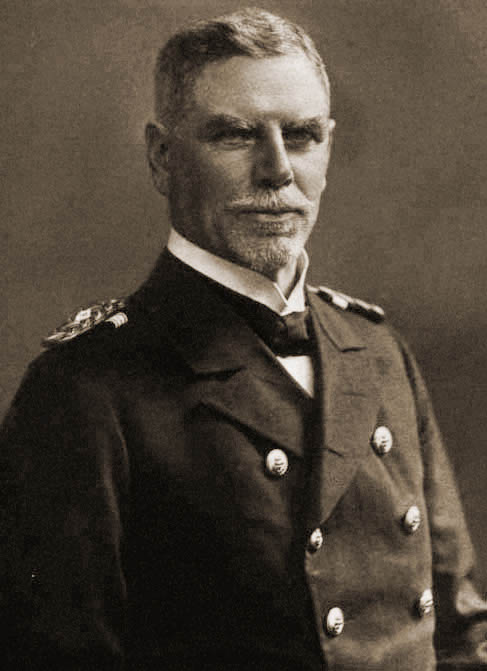
Maximilian von Spee
The outbreak of war found most of the German ships far from Tsingtau. Spee was steaming with his armored cruisers through the scattered German possessions in the Pacific, mostly picked up from Spain after the Spanish-American War, while Leipzig was attending to German interests on the Pacific coast of Mexico, with Nurnburg en route to relieve her. Spee summoned Emden and Nurnburg to join him in the Marianas, where he would be ideally placed to operate against Allied commerce in the Far East. But that plan would depend on the continued neutrality of Japan, and when Japan gave Germany an ultimatum on August 15th, he realized that it would be impossible to source sufficient coal for his squadron anywhere in the western Pacific or Indian oceans. The only remaining option was to head east, where the neutral countries of the Americas might still supply coal, and where Leipzig had succeeded in disrupting trade from Chile to Canada. Emden would be sent into the Indian Ocean, where she would conduct the Kaiserliche Marine's most successful cruise, while a few converted merchant ships remained in the Far East until they were hunted down or ran out of coal.
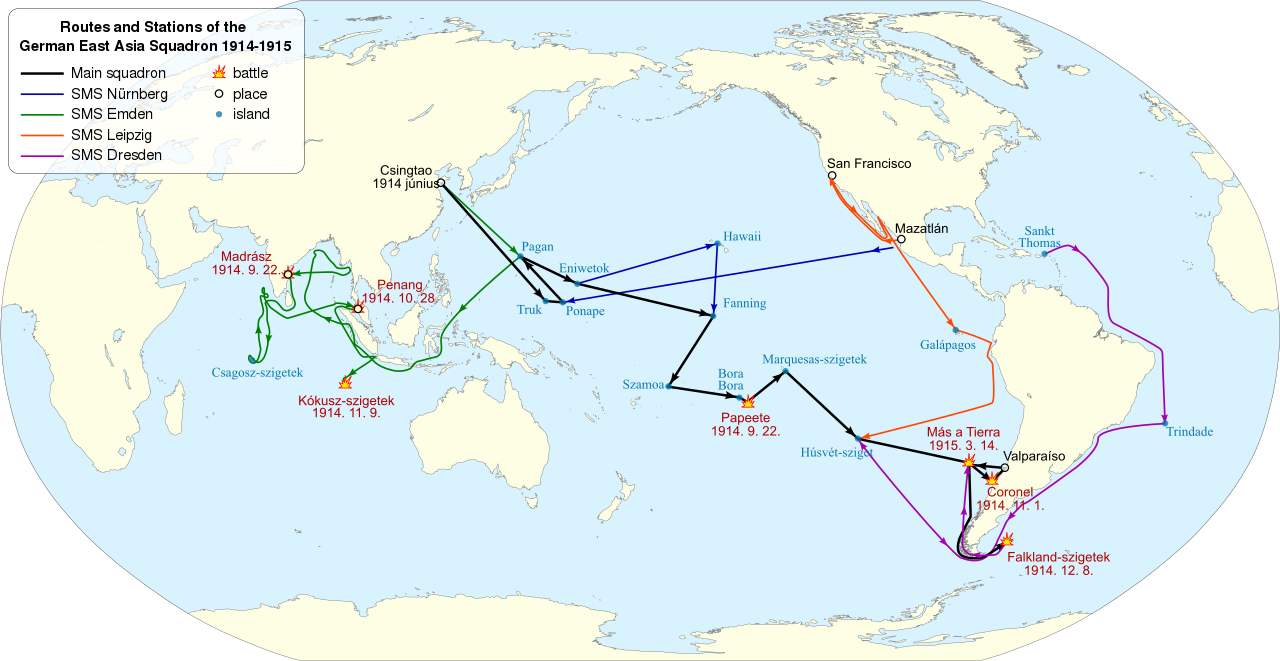
Spee headed slowly east, doing his best to conserve coal. Nurnberg was detached to pick up signals in neutral Honolulu, where she learned that the Allies had captured German Samoa. The squadron headed there in the hopes of catching Allied shipping at anchor, but found only an American schooner. An attack on the New Zealand garrison was considered, but ruled out due to the small force the cruisers could put ashore and the risk of damage to the German population. Instead, Spee sailed off to the northwest, successfully tricking the garrison into thinking he was headed for New Guinea, before turning east towards Tahiti, where he hoped to capture coal. The capital, Papeete, had 5000 tons of coal and was guarded only by an old gunboat, but the French responded to the Germans appearing over the horizon by scuttling their gunboat and setting fire to the coal. Spee bombarded the town, but decided that with the risk of mines and the lack of coal, there was no point sticking around, and headed east again.
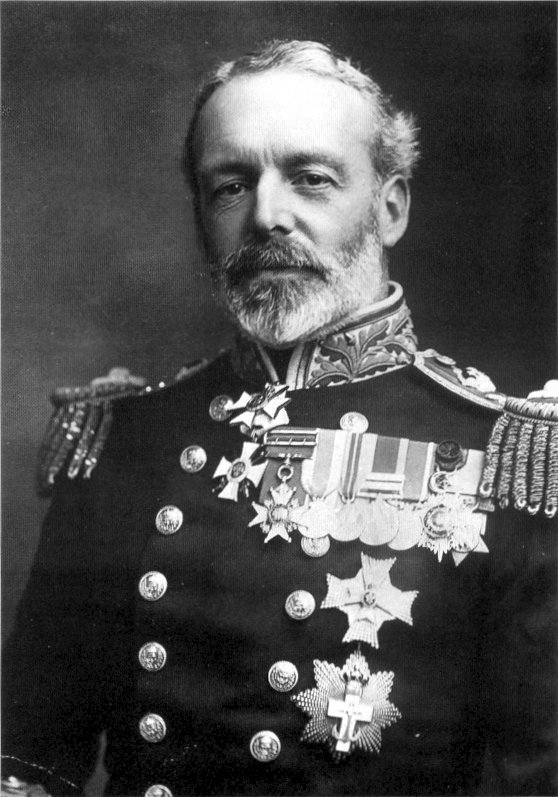
Christopher Cradock
After a brief stop in the northwestern corner of French Polynesia to take on more coal from his accompanying supply ships, Spee headed for Easter Island, where he would rendezvous with Leipzig and another light cruiser, Dresden, which had been in the Caribbean at the start of the war and had made the trip around Cape Horn. But despite his growing force, Spee knew his foes were closing in. A group built around HMAS Australia was now operating out of Fiji, while a force based in the Falklands under Rear Admiral Christopher Cradock prepared to block Spee's route home. Cradock had two old armored cruisers, Monmouth and Good Hope, the modern light cruiser Glasgow and armed merchant cruiser Otranto. This force was clearly outmatched by Spee, particularly given that the British armored cruisers had been hastily pulled from reserve and manned by scratch crews, while the German ships were among the cream of the Kaiserliche Marine. The Admiralty first tried to help by sending Cradock the old battleship Canopus and ordering him to keep in company with her, hoping she would serve as a "citadel" for his cruisers. Cradock, an Admiral with a reputation for being aggressive and headstrong, decided against this, taking his obviously inferior force to intercept the Germans and leaving Canopus, slow and no more heavily armored than Good Hope, to guard his colliers as he made a sweep to the western coast of South America. Spee had been careful to only use Leipzig's transmitter, and Cradock presumably thought he was chasing a single ship, although given his personality and statements at the time, particularly his expressed desire to avoid being court-martialed as Admiral Milne had been over the Goeben fiasco, it's unclear that he would have acted differently if he had known.
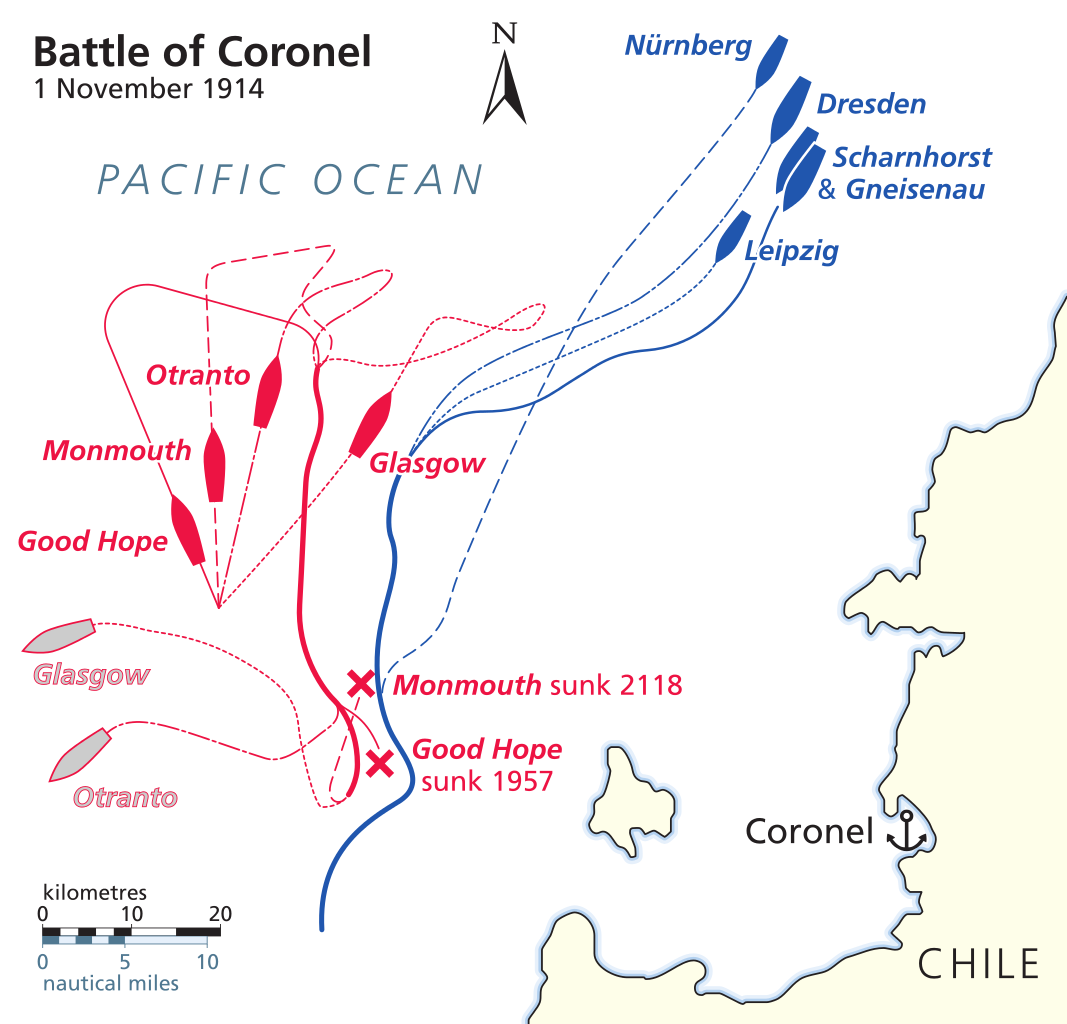
As the two forces slowly converged in late October, Cradock sent Glasgow into the Chilean port of Coronel to pick up any messages from the Admiralty. Spee learned of this and headed for Coronel, hoping to snap up the cruiser. He was too late for that, and the two forces met late in the afternoon on November 1st. Cradock probably could have avoided action, but he had expressed a wish to die either hunting or in battle, and he would get to fulfill that wish. The Germans were to the east, with the setting sun in their eyes, and Cradock charged, hoping to close in and end the battle quickly. Spee used his superior speed to keep his distance until the sun sank below the horizon, silhouetting Cradock's ships against the still-bright horizon. He then turned on the British, quickly pounding them with his broadside of a dozen 8.2" guns. Cradock's only heavy guns were a pair of 9.2" weapons aboard Good Hope, and while the battle opened at a range where he could in theory bring his 19 6" to bear, heavy seas made the casemate mounts that held most of those guns almost impossible to work. The German armored cruisers both landed hits on their opposite numbers within the first few minutes of battle, and within five minutes Monmouth fell out of the British line, while Otranto ducked behind Glasgow early on to protect her from German fire. Good Hope held her course, but despite the bravery of her crew, she was unable to land a single hit on Scharnhorst, her opposite number, before she blew up 50 minutes into the action, taking everyone onboard with her. She shifted her fire to Glasgow, but the light cruiser slipped away after landing a pair of hits on Scharnhorst. She had taken 5 4" hits from Leipzig and Dresden, but she was able to escape safely, along with Otranto. Monmouth was not so lucky, and Nurnburg found her two hours after the action began and sank her with all hands. She had managed to land a few hits on Gneisenau during their duel, but nothing that did more than temporarily impair the German cruiser's efficiency.
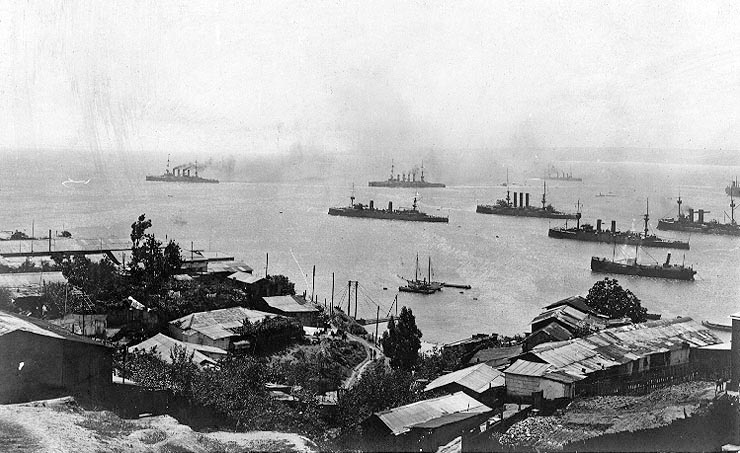
Von Spee's ships leave Valpariso after Coronel
The news of the defeat at Coronel was a tremendous shock to both sides. It had been a century since the Royal Navy had suffered a defeat at sea, and for a nation that had been raised to bask in the glory of Trafalgar, the destruction of Cradock's ships was inconceivable. Germany, meanwhile, was ecstatic, and Spee arrived in Valparaiso to a rapturous welcome from the town's large German population. But the Admiral himself knew well that this single victory was not enough to save his squadron, and when handed flowers by an admirer, remarked that they would do nicely for his grave. His five cruisers still had the entire Atlantic between themselves and home, and Coronel had used about half of their ammunition. The British would have their revenge, a subject we will take up next time.

Comments
I love how you spell Tsushingo three or four different ways in the article and charts.
The chart isn't my fault. I have no graphics skills, and use what I can find. As for the rest, I blame the fact that romanization is always a mess.
I am not complaining. I think there some value to getting them all out there, so you can reconize them if you stumble across one in a source.
Kinda reminds me of a poem:
“Forward, the Light Brigade!” Was there a man dismayed? Not though the soldier knew Someone had blundered. Theirs not to make reply, Theirs not to reason why, Theirs but to do and die. Into the valley of Death Rode the six hundred.
I worry the modern US Military (or at least the politician's expectations) has a similar overconfidence to Adm Craddock.
Craddock wasn't overconfident. He was pretty clear that he wasn't going to beat Spee, and decided to go in anyway because that was his personality. (Rules of the Game had some interesting commentary on this.) The British public might have been that overconfident. The Admiralty was confused, but didn't expect Craddock to engage. (I trimmed a bunch of extremely confusing stuff about that.)
I seem to recall Massie placing most of the blame on Churchill, who had been aggressively micromanaging from 10,000 miles away and who felt that Canopus provided enough firepower to deal with von Spee, and he had apparentu missed that Canopus was too slow for Cradock to bring it along and still be able to force action.
That's accurate for what Massie's view is, but I don't trust Massie quite enough to echo such criticism without doing more work to verify than I was able to before this went up.
Bean, can you link to the comments from Rules of the Game on Craddock. Always wondered about his decision making and would like to see another perspective
The summary version is that it was an age which valued gallantry (see the lionization of Robert Falcon Scott for his extremely stupid death for a clearer example) and Craddock was nothing if not gallant. He was also admittedly confused by the orders he was getting and decided that he wasn't going to end up like Troubridge and Milne. For the longer version, Rules of the Game is one of the best books I've read in a long time, and I highly recommend it.
I sometimes think that the 'Scott as stupid' angle is overstated.
The British expedition had put in a lot of metrological research both in Scott's final expedition, and the previous expeditions of Scott and Shackleton. They had also used dogs (ineffectively - they were badly advised on feed). But they had a reasonable plan to get to the pole and back.
The trip back had 3 components; the plateau journey back from the pole, the descent of the glacier down to the ross ice shelf and the final stretch along the ice shelf ('the barrier'). Now, when they reached the base of the glacier, they were in a relatively good place compared with the previous expeditions; 4 relatively fit travellers and some margin of food and fuel. And their research indicated they they should have good conditions for sledge pulling with a following wind for the sail.
What actually happened was possible the worst spell of weather in a century - temperatures dropping to -40F, where snow behaves more like sand and becomes impossible to drag a sledge through. What could have been 15 mile days became 6-7 mile days, meaning that food and fuel ran out and limbs froze.
Now, the Norwegians did much better - but were more experienced to start with (and their base was on a bit of ice shelf that broke off not long after - history could have been very different). But Scott's plan was not stupid or hopeless, it was based on the knowledge they had and if it had't been for some freakishly cold weather, it would have worked.
(See 'Susan Solomon - The Coldest March')
(also, apologies for the rant, love the blog, I blame it on my missing out the the British Antarctic Survey in my youth)
I admit that my main influence on this was Scott and Amundsen, which is rather earlier, and I haven't looked into this much since I read that. At the same time, there were several rather obvious mistakes which cut Scott's margin significantly (the decision to take 5 rather than 4 to the pole is the most obvious). I think my biggest criticism of the recent revisions to Scott is that while the weather may have finished him off, it was his own mistakes that put him in that spot in the first place. (The Swiss Cheese Model as applied to polar exploration.) Amundsen did a much better job on a lot of levels. Leaving food behind on the way back deserves celebration.